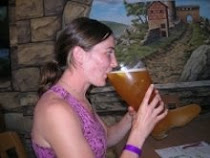Last night Leah and I brewed our first all grain beer! One thing is for certain. All grain brewing is a lot more fun then just brewing extract!! You definitely get a sense of actually creating your beer with all grain rather then just the "beer in a can" method of extract. While both have their pros and cons, I'm happy that we switched.
The Mash
The first step to begin the mash is the heating of the strike & tun preheat water. Instead of trying to preheat the mash tun, add the strike water, and then try to adjust to proper temp, I heated the strike water about 15° warmer then what it should be. The extra heat will then go to preheat the mash tun. Once the strike water has cooled to it's proper temperature (169°), we began the mash in (left). Beersmith, which by far is the most handy tool a brewer could have, calculates my strike temperature for me, by taking into account how much the grain will cool the water to the proper mash temp (154°).
The grain absorbs and cools a large amount of the water in the tun, as we mixed it in. My mash temperature for this recipe is 154°, and the grain cooled my water down to only 156°, so I ended up having to add a bit of cooler water, and then stir it up again to cool it by those last 2 degrees. The mash time for this beer is 60min. The round cooler worked perfectly, and only dropped 1° for the entire mash!
The Sparge
After the 60 minute mash is complete, it is time to rinse the grains. The reason you need to rinse the grains is because there are large amounts of residual sugars that are stuck to the grains. If you don't rinse these off, you end up losing them.
The sparge technique we chose is known as "No Mashout, Double Batch Sparge".
From John Palmer's How to Brew, which is the most extensive online resource for home brewers, "Mashout is the term for raising the temperature of the mash to 170°F prior to lautering. This step stops all of the enzyme action (preserving your fermentable sugar profile) and makes the grainbed and wort more fluid." Instead of doing a mashout, we are using hotter then normal sparge water (180°). This will raise our mash temperature and stop our enzyme action, while at the same time saving us a step.
A Batch Sparge is a sparge technique where by the brewer will drain all the mash water out of the mash/lauter tun and into the boil kettle. The tun is then filled again with the sparge water, mixed throughly for 5 minutes, then is again drained completely into the kettle. Each time the tun is drained, less and less sugars are being removed, and the runnings are clearer. We will be doing a double batch sparge, which means our tun will batch sparged twice.
Before each draining of the tun, a brewer will want to do what is called a "Vorlauf". A vorlauf is a fancy German word for recirculating the first few quarts of runnings back into the top of the tun. The grainbed will act as a natural filter when draining the sparge water, however, the first few quarts that exit the tun after mixing will be filled with large amounts of sediment. By collecting this sediment filled wort, and returning it back to the top of the tun, we can use the grainbed to filter this out.
The brewer will need to vorlauf each time the grain bed is disturbed. In our case, we had to do it after collecting the mash water, and then once with each sparge.
The Boil
Boiling an all grain beer is exactly the same as an extract brew, except for the fact you're boiling a lot more! The burner had a tough time keeping the kettle at a rolling boil with how hard the wind was blowing. We had a preboil volume of 6.5 gallons, and expected a gallon and a half to boil off. However, we only got down to 5.5 gallons. This may leave our beer a little bit weaker then we were expecting. Beersmith had our ABV estimated around 4.8%, however we likely may only reach close to 4.0%. The beer should come out of the primary in a week, so we shall see then.





